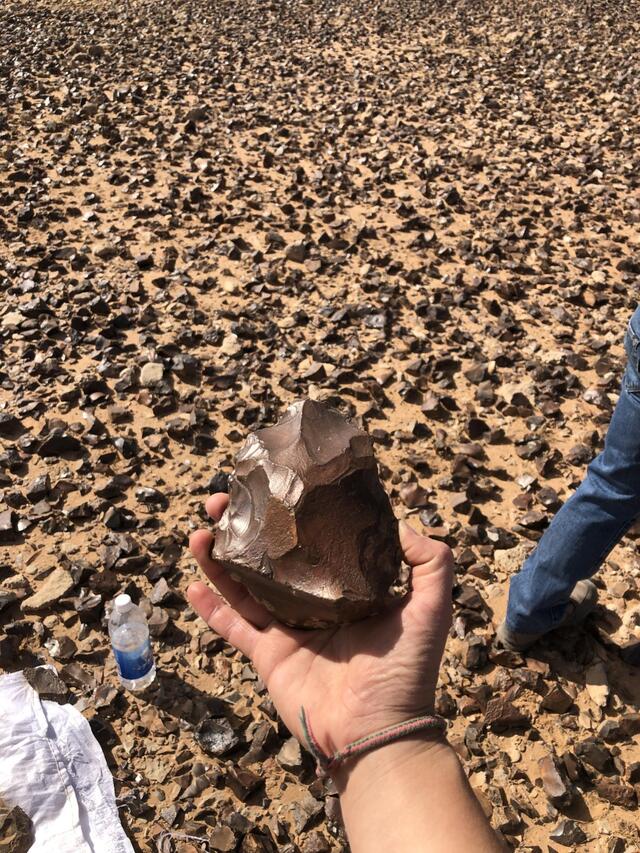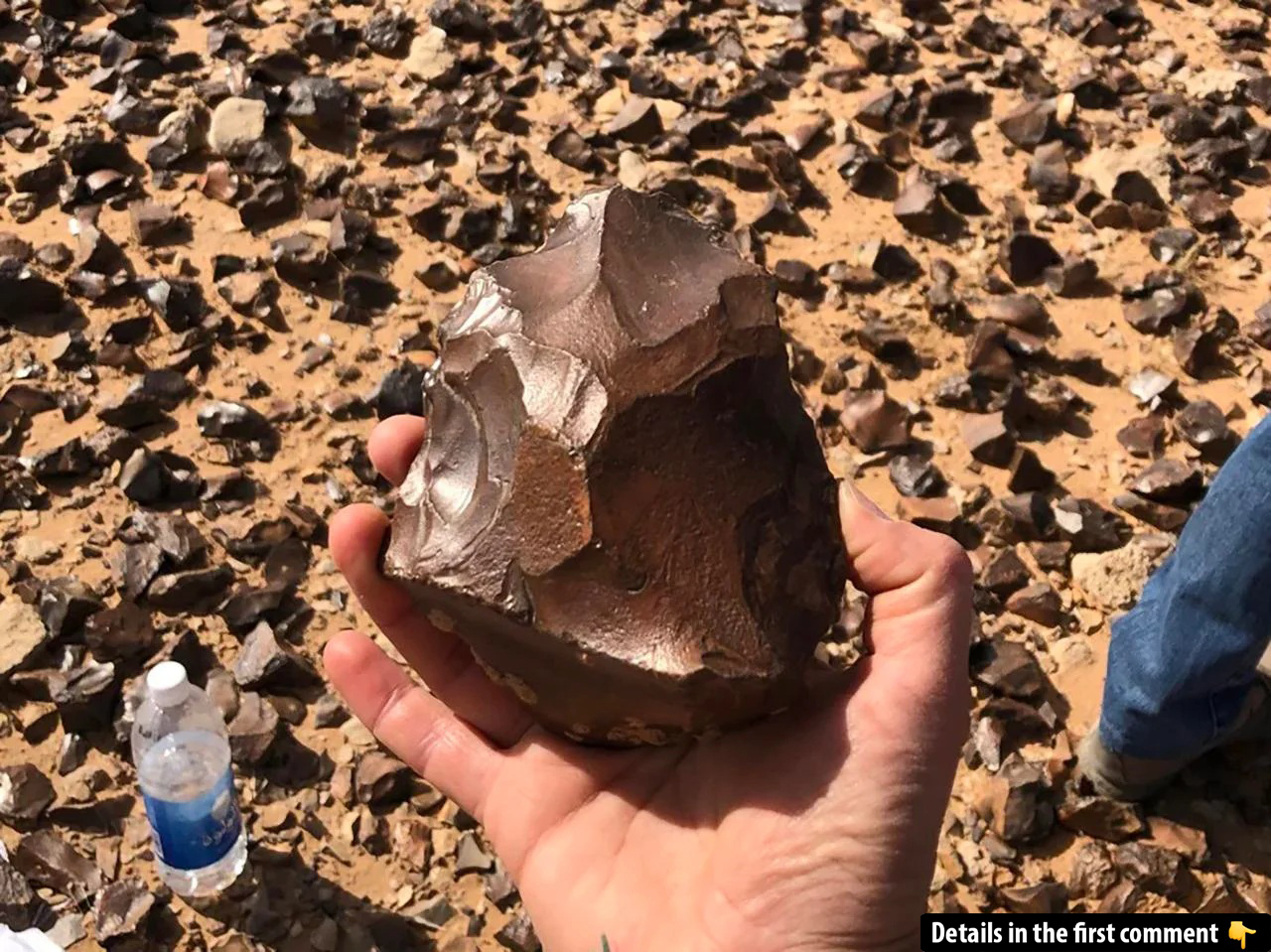In the vast stretches of Iraq’s Western Desert, a groundbreaking discovery has unearthed ancient tools that tell a story of early human ingenuity. A team of archaeologists recently uncovered over 850 stone tools from the Paleolithic era, including 1.5-million-year-old hand axes. These finds offer a glimpse into the lives of our distant ancestors and shed light on human evolution in one of the world’s most challenging environments.
The Discovery: Unearthing 1.5-Million-Year-Old Hand Axes
Led by Ella Egberts, the team’s fieldwork was centered around the now-dry lakebed of the Al-Shabakah region. The area, once home to a vast lake during the Pleistocene era, is crisscrossed with ancient dry riverbeds known as wadis. These features created an ideal environment for preserving archaeological material, and the team’s efforts have paid off. In their investigation, they unearthed over 850 artifacts, including tools from the Lower and Middle Paleolithic periods. Among the most significant finds were hand axes, which date back to approximately 1.5 million years ago.
The Lower Paleolithic hand axes are among the oldest tools discovered in the region, offering a rare window into the technological advancements of early humans. These hand axes, made from stone, were likely used for a variety of tasks, such as butchering animals and cutting plant materials. Additionally, the team found Levallois reduction flakes, which are characteristic of the Middle Paleolithic period, dating back between 300,000 to 50,000 years ago. The discovery of these tools provides valuable evidence of the technological evolution that took place over hundreds of thousands of years.
Video
Watch this video to explore the mystery behind millions of ancient objects created by humans—yet their purpose remains unknown.
A Glimpse into the Past: What the Artifacts Reveal

The artifacts uncovered in the Al-Shabakah region are not just remnants of a distant past; they tell a compelling story of survival, adaptation, and innovation. The hand axes and Levallois flakes found at the site reveal the advanced technological skills of early humans. The Levallois technique, for example, involves the preparation of a stone core to produce specific types of flakes, demonstrating a level of planning and foresight that was previously thought to be characteristic of later human species.
The presence of these tools in the desert region suggests that early humans were adept at exploiting the environment around them. The dry riverbeds and ancient lakebed would have provided ample resources for hunting and gathering, and the tools found at the site indicate that these early human populations were capable of efficiently processing these resources. The discovery of such a wide variety of tools at multiple sites in the region points to a long history of human activity, stretching across millennia.
The Role of the Landscape: Ancient Lakes and Dry Riverbeds
The Al-Shabakah region, once home to a vast Pleistocene lake, has preserved these archaeological treasures for thousands of years. The landscape of the area, with its dry riverbeds (wadis) and ancient shoreline, has created an environment that allowed these tools to remain intact for millions of years. The lake, which is believed to have existed during the Pleistocene epoch, would have been a crucial resource for the early human populations that lived in the region.
The now-dry lakebed offers a unique snapshot of the ancient environment in which early humans lived. The researchers are using the findings from this site to reconstruct the environmental conditions of the time, gaining insights into how early humans adapted to their surroundings. The landscape, once teeming with life, is now a desolate desert, but the artifacts found here remind us of a time when it was a vital resource for prehistoric humans.

The Educational and Cultural Impact: Training Iraqi Students
One of the key elements of the project was its focus on education and outreach. During the fieldwork, three Iraqi archaeology students participated in the excavation, learning valuable skills in geoarchaeology and Paleolithic archaeology. This hands-on experience provided these students with the opportunity to engage with the region’s rich prehistoric past and gain practical knowledge that will benefit their future careers in archaeology.
In addition to training students, the research team also held a workshop at Al-Qadisiyah University, where they shared their findings and inspired more students and academics to explore Iraq’s prehistoric heritage. This initiative is particularly significant in a country that has been embroiled in conflict for many years. By focusing on archaeology, Egberts and her team are fostering a new generation of scholars who can contribute to the understanding and preservation of Iraq’s cultural heritage.
Future Steps: Expanding the Research and Excavation
The discoveries made in the Al-Shabakah region are just the beginning. The research team, led by Egberts, plans to expand their study area and conduct in-depth analyses of the artifacts. By systematically exploring all the sites in the region, they hope to uncover even more about the technological advancements of early humans. Further excavations will provide a clearer picture of how these early populations lived, hunted, and interacted with their environment.
In addition to the artifacts, the team is also focused on reconstructing the environmental changes that occurred during the Pleistocene. By studying the geomorphology of the region and analyzing the stratigraphy of the soil, the researchers aim to piece together a more comprehensive understanding of the ancient landscape and the climate in which these early humans lived.
Challenges and Successes: Navigating Research in Iraq
Conducting archaeological research in Iraq presents unique challenges, given the country’s complex political and security situation. However, despite these challenges, the team was able to carry out their work without significant issues. Egberts noted that the team faced numerous checkpoints and logistical obstacles but was able to navigate these challenges with the support of local authorities.
“The Iraqi State Board of Antiquities and Heritage appreciates our work and encourages us to continue,” Egberts said. This support has been crucial in allowing the team to continue their research and contribute to the broader field of archaeology. The successful completion of this project is a testament to the resilience and determination of the research team, as well as the importance of international collaboration in advancing archaeological knowledge.
Video
Tune into this video from BBC News to discover ancient rock carvings uncovered in Iraq, offering new insights into the region’s history.
Conclusion: The Significance of the Findings for Archaeology and Human History
The discoveries made in Iraq’s Western Desert have far-reaching implications for our understanding of early human life. The hand axes and Levallois flakes uncovered in the Al-Shabakah region provide valuable insights into the technological advancements of Paleolithic humans. By studying these artifacts, archaeologists can gain a deeper understanding of how early humans adapted to their environment, developed new technologies, and shaped the course of human evolution.
As Egberts and her team continue their work in Iraq, the importance of these discoveries will only grow. By expanding the research area and analyzing the artifacts in more detail, they are poised to uncover even more about the prehistoric past. In a region often overshadowed by modern conflicts, these discoveries offer a glimpse into the distant past, reminding us of the long and fascinating history of human life in the Middle East.



